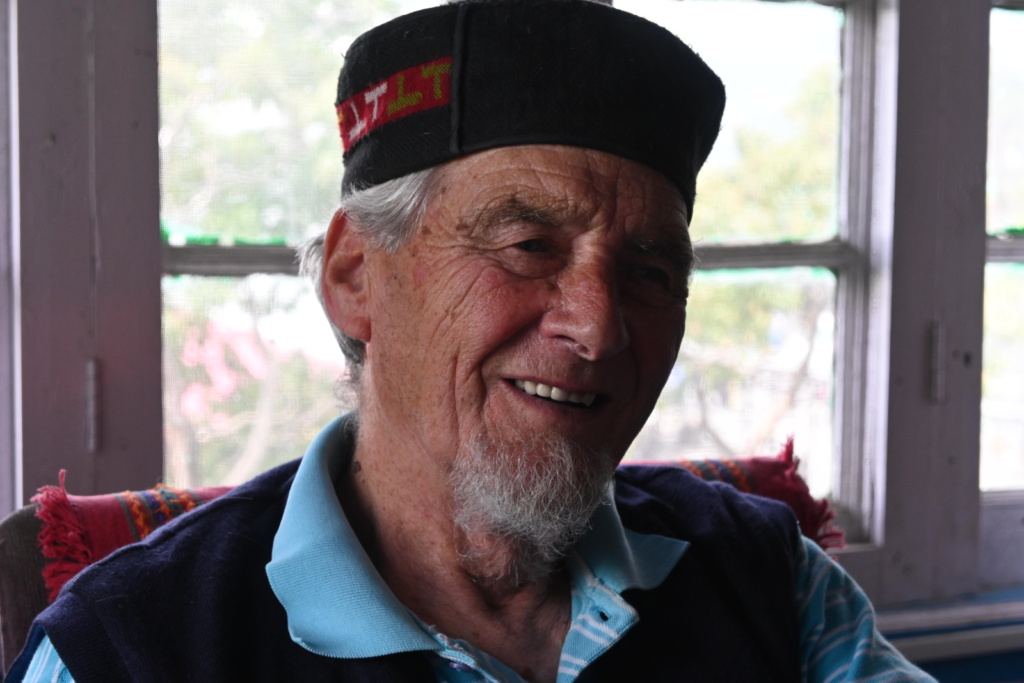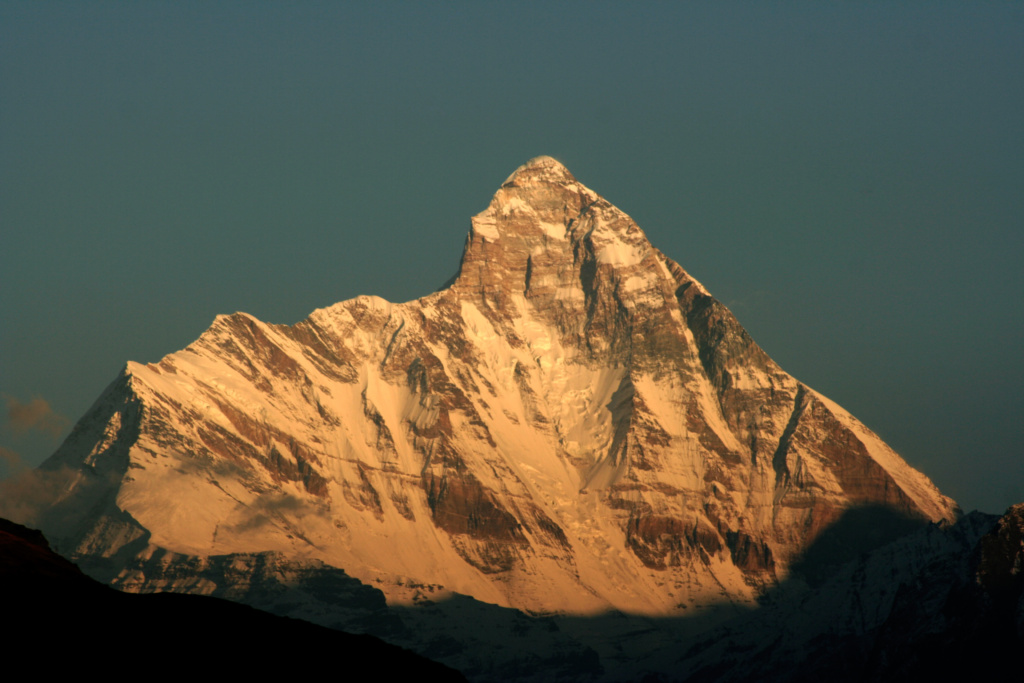At a library in Calcutta, Bill Aitken stumbled upon the gorgeous mountain in the late 50s. It’s been his muse ever since.

First published: https://www.firstpost.com/india/shes-given-meaning-to-my-life-at-88-bill-aitkens-love-for-nanda-devi-remains-as-young-as-ever-10888781.html
‘She’s given meaning to my life’: At 88, Bill Aitken’s love for Nanda Devi remains as young as ever
Although Bill Aitken studied comparative religion as a student, Nanda Devi has always been his mountain goddess once he started living closer to her
In the upper reaches of Uttarakhand stands a mountain that has an aura, quite unlike the other giants that rise around it. Or perhaps “her” would be a more appropriate reference, given that this mountain, Nanda Devi, is a manifestation of Goddess Parvati and is worshipped as a deity in the region.
The double-humped giant has been a source of fascination for all kinds of people. The local populace revere her for centuries now and has built temples in her honour. Even before Nanda Devi (7,816m) was declared the highest mountain in British India, mountaineers and explorers were fascinated by her exquisite form. As for author Bill Aitken, he was simply “khenchoed” or drawn in by her grace.
It’s a rather pleasant May morning in the hill town of Landour, a short hop from the bustling tourist hub of Mussoorie. The only landmark I have to Aitken’s home is the Wynberg-Allen School. Most folks I enquire with haven’t heard of him, nor are they aware of his home, Oakless. One gentleman suggests I check with the neighbourhood grocery store that has been around for “40-50 years”. As I continue along the steep downhill path, a boy jumps out from one of the gates by the wayside.
“Do you know where Bill Aitken stays?” I ask.
“Right here, he lives here,” the boy responds.
Just the luck I needed after an unusually early morning trudge! As I step in, the incessant yelps of dogs announce my arrival. I’m shown into a cosy wooden cottage by Aitken’s dogs, Frida and Freddie. He sits easily at his desk that overlooks Dehradun in the hazy valley below. Aitken dons a traditional Garhwali hat and a light woollen sweater for the summers. And as it turns out, quite unknowingly, I am the first visitor to wish him his 88th birthday.
“And please don’t say – may you live to be a hundred years. The thought is nice, but one’s body aches and pains at this age. Ninety bohot hai (Ninety is about enough)!” he says, an impish smile beaming from behind his white goatee.

There are books that sit pretty in every nook and cranny of his room. It includes The Nanda Devi Affair, the culmination of his tryst with the mountain, which he wrote around three decades ago. Right above him rests a photo of the same mountain that has been his muse since he first arrived in India from Scotland in 1959.
“I grew up in front of a very small hill called Dumyat. It was nothing too big, but from the flatland, it looked impressive. I hated going to church but loved sitting on top of that peak. I felt like one with the universe. And I thought, this is divinity,” he recalls.
After pursuing comparative religion, he set off on a trip around the world to study different religions with just fifty pounds in his pocket. Once he ran out of money in Calcutta (now Kolkata), he had to consider taking up a teaching job.
Then one day, he stepped inside the Asiatic Society Library on Park Street. Little did he know that his academic quest would make way for a more life-changing event at that moment. It’s when he discovered the book, Nanda Devi, written by the legendary British explorer, Eric Shipton.

Photo credit: Michael Scalet/Wikimedia Commons
“The person who entered that library was not the same person who came out. I was totally hooked, my destiny possessed by this mountain. I knew I had to go touch the feet of the Devi,” he says.
All plans to continue his travel were put on hold. And as things would pan out in the time ahead, Aitken would make India his home ever since.
“I studied comparative religion to understand what divinity is. And I found the answer in Nanda Devi,” he says.
In 1960, he arrived at an ashram in Kausani where he worked as a gardener for four years. It was also where he had his first glimpse of the peak. He was soon learning about the significance of this mountain in the local Kumaoni and Garhwali culture, including the Nanda Devi Raj Jaat – a yatra that takes place every 12 years in honour of the Goddess.
“I went to a devta naach, which the folks at the ashram were not too happy about since it involves superstition. But it was in honour of Nanda Devi, so I had to go. Then, when I got typhoid, they said it was bad karma. I fasted for 40 days instead of taking medicine and during this time, had a tremendous epiphany on the real state of the universe,” he says.
Over time, the mountain became an obsession. Whenever he could steal days from his schedule, he would set off for the areas around Nanda Devi to admire her charms and learn more about her lore. The desire was to get to the base of the mountain someday and pay his respects, which had always been a task given her strategic location.
Nanda Devi stands in the middle of two concentric rings of equally high mountains that guard her like sentinels. The only feasible approach is via the Rishi Ganga gorge, which poses a daunting challenge given the steep, weathered walls that have to be traversed and the raging river below. In the past, it had defeated many explorers, until Shipton and Bill Tilman forged a passage in 1934.
After multiple visits to the area, Aitken could finally follow in Shipton’s footsteps in 1980 and get his first close encounter with the mountain.
“It was the end of July and the monsoon was at its peak. I didn’t see a snow summit for the entire 10 days. Then as I sat looking at this cloud, it suddenly cleared up and I saw the top of the mountain. It was like a special darshan, what I call a spiritual striptease. That was the climax of my visits,” Aitken recalls.
But while rambling around the Nanda Devi Sanctuary, as the immediate area surrounding the mountain is known as, he also observed the impact that unregulated climbing expeditions were having on the area. There was litter strewn in places, vegetation had been razed to provide fuel for the teams and pack animals had resulted in overgrazing of the land. It was a far cry from the wonderland that Shipton had described in his books.
He had also heard of the various disasters associated with the mountain. Like how an Indo-American team made an unsuccessful attempt at planting a nuclear-powered spying device on Nanda Devi in 1965, which had eventually gone missing. Or the tragic death of Nanda Devi Unsoeld, the daughter of renowned American climber Willi Unsoeld, during an expedition in 1976.
“I very stupidly recommended that the Nanda Devi Sanctuary be closed. In hindsight, I should have just kept my mouth shut. The villagers were really upset because they lost their livelihoods – they were making good money through the foreign expeditions. They looked at me as a betrayer of their interests. Then, a lot of young mountaineers blamed me for not being allowed inside,” he says.
“My motive was for the good of the Devi, to protect the area. But I feel like I made a mistake,” he adds.
In 1988, the Nanda Devi Sanctuary was included in the UNESCO list of World Heritage Sites and continues to be out of bounds even today. Aitken has written an afterword of sorts to his book to provide an update on the condition of the area and the people who depend on it.
“And I’m also trying to justify why I was so stupid in opening my mouth about closing the Sanctuary. I hope it finds its way into print someday,” he says.
Even at his age, he continues to make an annual pilgrimage to Surkanda Devi Temple, around 40km from his home. It’s a spot from where he can admire Nanda Devi in the distance.
“She’s my Devi, a Mountain Goddess – the most beautiful thing in life. But you cannot explain this to anyone. She’s given meaning to my life,” he says.
Another visitor brings him back to the present with a bouquet of flowers to celebrate his birthday. As he takes leave, Aitken says, “Bohot meherbani (Thank you very much), Jai Nanda Devi!”